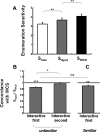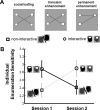Collective enumeration
- PMID: 22889187
- PMCID: PMC3607463
- DOI: 10.1037/a0029717
Collective enumeration
Abstract
Many joint decisions in everyday life (e.g., Which bar is less crowded?) depend on approximate enumeration, but very little is known about the psychological characteristics of counting together. Here we systematically investigated collective approximate enumeration. Pairs of participants made individual and collective enumeration judgments in a 2-alternative forced-choice task and when in disagreement, they negotiated joint decisions via verbal communication and received feedback about accuracy at the end of each trial. The results showed that two people could collectively count better than either one alone, but not as well as expected by previous models of collective sensory decision making in more basic perceptual domains (e.g., luminance contrast). Moreover, such collective enumeration benefited from prior, noninteractive practice showing that social learning of how to combine shared information about enumeration required substantial individual experience. Finally, the collective context had a positive but transient impact on an individual's enumeration sensitivity. This transient social influence may be explained as a motivational factor arising from the fact that members of a collective must take responsibility for their individual decisions and face the consequences of their judgments.
Figures




References
-
- Abrams D., & Hogg M. A. (1988). Comments on the motivational status of self-esteem in social identity and intergroup discrimination. European Journal of Social Psychology, 18, 317–334. doi:10.1002/ejsp.2420180403
-
- Bahrami B., Olsen K., Bang D., Roepstorff A., Rees G., & Frith C. (2012a). Together, slowly but surely: The role of social interaction and feedback on the build-up of benefit in collective decision-making. Journal of Experimental Psychology: Human Perception and Performance, 38, 3–8. doi:10.1037/a0025708 - PMC - PubMed
-
- Behrens T. E., Hunt L. T., & Rushworth M. F. (2009). The computation of social behavior. Science, 324, 1160–1164. doi:10.1126/science.1169694 - PubMed
Publication types
MeSH terms
Grants and funding
LinkOut - more resources
Full Text Sources
Other Literature Sources
Medical

